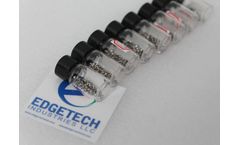Refine by
Biocompatibie Articles & Analysis: Older
94 articles found
Enhancing Product PerformanceSpecialty chemicals play a vital role in the performance and longevity of medical devices. These chemicals are used in coatings, adhesives, sterilization processes, and biocompatible materials that ensure safety and functionality. For example, hydrophilic coatings enhance the comfort and efficiency of catheters, while high-purity adhesives are indispensable in ...
At a time when medical imaging technology is rapidly advancing, one of the oldest materials, platinum iridium marker bands, still stands out as the gold standard in medical imaging. While more modern alternatives have been developed over recent years that offer cheaper and lighter solutions, few can match this classic material's reliability and durability. For anyone requiring precise results ...
Copolymers are a class of polymers that consist of two or more different monomeric units. The process of creating these versatile materials is fundamental to a variety of applications in industries ranging from plastics and rubber to biomedical devices and textiles. Understanding how copolymers are made involves a grasp of the underlying chemistry, synthesis techniques, and the properties that ...
Liposomes, spherical vesicles composed of one or more phospholipid bilayers, have garnered significant attention in the field of drug delivery due to their unique properties. These nanocarriers offer a promising approach to overcome challenges associated with traditional drug administration, enhancing therapeutic efficacy while minimizing side effects. This article will delve into the role of ...
The field of medicine is constantly evolving, with new procedures and technologies emerging that improve patient outcomes and reduce recovery times. As these innovations advance, the materials that make them possible become increasingly important. One such group of materials, fluoropolymers, is proving to be essential for a variety of cutting-edge medical procedures. Known for their exceptional ...
Ovalbumin, also known as albumin or OVA, is the most abundant protein found in egg white, accounting for approximately 54% of its total protein content. This versatile glycoprotein has captivated researchers and industry professionals alike due to its unique properties and wide-ranging applications. In this article, we'll explore the structure, functions, and diverse uses of ovalbumin in various ...
Polyethylene glycol (PEG) derivatives have become pivotal in the pharmaceutical industry, revolutionizing drug delivery systems and enhancing the efficacy of various therapeutic agents. The unique properties of PEG derivatives, including their biocompatibility and ability to modify the solubility, stability, and bioavailability of drugs, make them indispensable in modern pharmacology. This ...
Medical device biocompatibility testing is a quality control standard for the development and manufacturing of medical devices. Biocompatibility testing evaluates the effect of a medical device on human tissues to determine whether it can cause biological reactions such as toxicity, physiological, immune, or mutation. Biocompatibility testing is a key process to ensure the safety and ...
Dendrimers are highly branched polymers with a three-dimensional structure. They are characterized by expansive functional groups on their surface, which can be tailored to interact with specific molecules or to be used in a variety of applications. Dendrimers have attracted much attention in drug delivery, imaging, and materials science due to their unique structure, high monodispersity, and ...
The field of biomaterials is undergoing a transformative shift, driven by the integration of artificial intelligence (AI) technologies. As the demand for advanced materials with tailored properties continues to grow in applications ranging from tissue engineering to medical devices, researchers are increasingly turning to the power of AI to accelerate biomaterials development and optimization. ...
The chemical industry, a cornerstone of global industrial activities, continues to evolve in response to dynamic market trends, technological advancements, and shifting regulatory landscapes. Among its many sectors, the market for silicone materials stands out due to its versatility, wide range of applications, and growing demand across various industries. Current Market Status As of 2024, the ...
Polymers play an important role in the biomedical field, and polyethylene glycol (PEG) and its derivatives are among the multifunctional polymers that have attracted much attention. PEG is a synthetic macromolecule with a linear structure consisting of glycol units (-CH2CH2O-) repeatedly linked. Its unique properties give PEG a wide range of applications. PEG is soluble in organic solvents and ...
Click chemistry has revolutionized the field of bioconjugation, offering a robust and versatile approach for linking biomolecules, such as proteins, peptides, nucleic acids, and carbohydrates, to create novel materials and probes. Traditionally, copper-catalyzed azide-alkyne cycloaddition (CuAAC) has been the cornerstone of click chemistry, but concerns about cytotoxicity and metal contamination ...
POCT (Point-of-Care Testing) refers to clinical and bedside testing conducted in close proximity to patients. It is often not performed by clinical laboratory personnel. POCT holds significant importance in disease prevention, etiology determination, prognosis, enhancing treatment outcomes, and reducing healthcare expenses. It meets clinical testing needs across various healthcare settings. POCT ...
Poly(lactic-co-glycolic acid) (PLGA) is a functional polymer organic compound randomly polymerized by lactic acid (PLA) and glycolic acid (PGA). It has been approved by the U.S. Food and Drug Administration It is certified by the Food and Drug Administration (FDA) and is a copolymer material available on the market. PLGA has good biocompatibility, biodegradability, mechanical strength, good ...
The three main components of tissue engineering applications are scaffold, cell and growth-stimulating signals. Collagen has been widely used in the clinical field due to its abundance in nature, biocompatibility, low antigenicity and biodegradability. In addition, the high tensile strength and fibril-forming ability of collagen enable it to be made into various forms such as tissue grafts, ...
Electrospinning can produce continuous fibers on the micro - and nano-scale. The high flexibility and low cost of the material make electrospinning very attractive. In addition, the high specific surface area, porosity, and similarity to ECM ensure that the electrostatic pad promotes cell adhesion, skin regeneration, nutrient and oxygen transport, moisture retention, exudate removal, and ...
The field of medicine is constantly evolving, with researchers and scientists striving to find innovative ways to deliver drugs effectively and efficiently. One of the most promising technologies that has emerged in recent years is nanoparticle development for drug delivery systems. Nanoparticles are tiny particles with dimensions in the nanometer range, making them ideal for targeting specific ...
Introduction Microneedles have gained significant attention in recent years due to their potential applications in various fields such as drug delivery, diagnostics, and tissue engineering. The preparation of microneedles requires precise and efficient technologies to achieve desired features such as size, shape, and mechanical strength. This article provides an overview of different ...
Introduction of 3D Printing Materials 3D printing has revolutionized the manufacturing industry, allowing the creation of complex and customized objects with ease. One critical aspect of 3D printing is the materials used, which greatly impact the functionality and compatibility of the final product. What are Biocompatible Materials in 3D Printing? Biocompatible materials play a crucial role in ...













